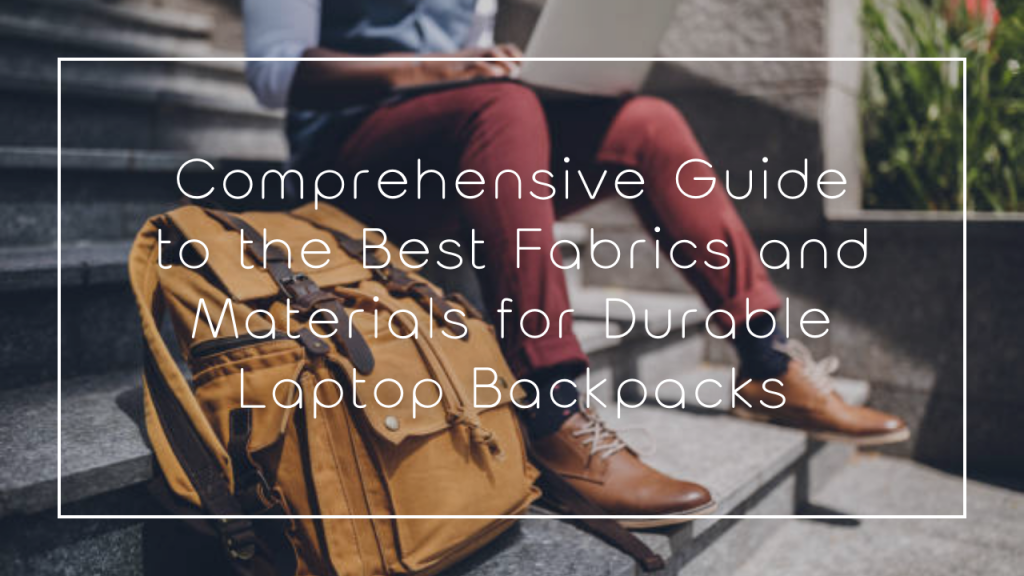
Choosing a laptop backpack involves finding the right balance between style and functionality, and the material is crucial in ensuring durability, water resistance, and overall protection for your electronics. Here’s a look at some of the best fabrics and materials used in making durable laptop backpacks:
High-Performance Synthetic Fabrics
Nylon (including Ballistic and Cordura)
Ballistic Nylon: Initially intended for military flak jackets, ballistic nylon is extremely durable and resistant to tears, scuffs, and abrasions. It’s a top choice for heavy-duty use.
Cordura Nylon: This fabric is known for its durability and resistance to abrasions, tears, and scuffs. It’s lighter than ballistic nylon but still very strong.
Ripstop Nylon: Identified by its grid pattern, ripstop nylon is excellent for its lightweight, waterproof, and tear-resistant properties.
Polyester
Polyester is a common material for backpacks because it’s relatively lightweight and available in various degrees of thickness and durability. High-denier polyester offers more strength and durability. It’s also less expensive than high-end nylon products, though generally less durable.
Timeless and Robust Natural Materials
Leather
Often chosen for its luxurious look and feel, leather is also exceptionally durable and can last for years if properly maintained. However, it’s heavier and requires more care, and it’s not inherently water-resistant. There are also vegan leather options with varying durability.
Canvas (often waxed)
Canvas is known for its durability and sturdiness. Waxed canvas has the added benefit of being water-resistant, and it develops a unique patina over time. However, it can be heavier than nylon or polyester options.
Advanced and Specialized Coatings
TPU (Thermoplastic Polyurethane) & PVC (Polyvinyl Chloride) Coated Fabrics
These materials are often used as a coating over other fabrics, like nylon or polyester, to provide a waterproof layer. Backpacks with these coatings are useful in rainy climates or for individuals who need additional protection against liquid damage.
Kevlar
Known for its use in bulletproof vests, Kevlar is a synthetic fiber that’s incredibly tough and tear-resistant, often used in high-performance gear. It’s not commonly used for entire backpack structures due to its cost and rigidity but might be found in high-wear areas or special items.
Additional Durable Materials and Components
Oxford Fabric
Often made from cotton, polyester, or a blend, Oxford fabric is versatile, reasonably durable, and typically more affordable. It’s not the toughest material on the market, but it’s often treated with chemicals to resist water and mildew, making it more durable.
HPDE (High-Density Polyethylene) Framesheets
Though not a fabric, HPDE framesheets are sometimes used in laptop backpacks to provide additional structural integrity and protection. They help the backpack maintain its shape and protect the laptop from any impact or stress, especially if you’re carrying heavy books or items.
Neoprene
This soft, flexible rubber material is often used inside laptop backpacks as a form of cushioning or in laptop sleeves due to its water-resistant and shock-absorbent properties. It’s not used for the backpack’s overall structure, but it’s a valuable material within the construction.
PVC Tarpaulin
This heavy-duty plastic-coated material is known for being waterproof, robust, and durable. It’s often used in waterproof backpacks or bags used for water-related activities. It’s not the most flexible material, but it is virtually impenetrable by water.
Considerations Beyond Fabric
Faux Leather (Polyurethane)
An alternative to real leather, faux leather made from polyurethane (PU), provides a similar look and feel without using animal products. It varies in durability and quality but usually offers reasonable resistance to water and stains. However, it might not be as long-lasting as high-quality genuine leather.
Mesh Fabric
While not used as the main material, breathable mesh is often applied to the back panel and shoulder straps of laptop backpacks for increased airflow and comfort. It helps reduce sweat and discomfort during prolonged use, especially in warmer climates or while biking.
Reflective Materials
For those who commute in the dark or in heavy traffic, reflective materials are a safety feature on backpacks. These might be incorporated into the design with reflective threads woven into the fabric or as strips or patches.